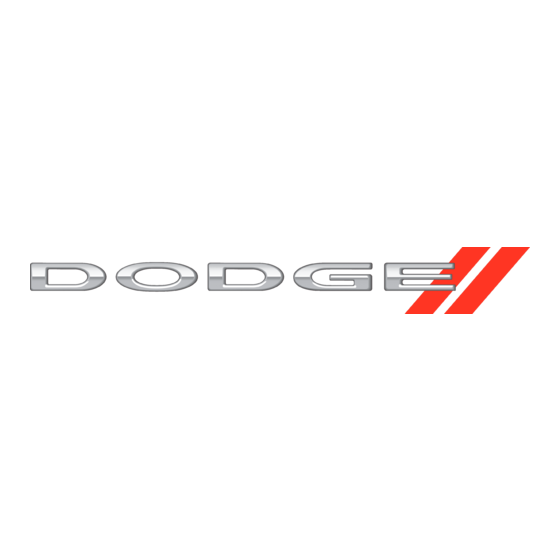Dodge MRC-TC06NC Інструкція з експлуатації - Сторінка 2
Переглянути онлайн або завантажити pdf Інструкція з експлуатації для Приводи постійного струму Dodge MRC-TC06NC. Dodge MRC-TC06NC 4 сторінки.

REPLACEMENT PARTS
With access to an arbor press, equipment for heating and
shrinking bearings and gears on shafts, and the tools normally
found in a maintenance department, the MIMA SCXT325A speed
reducer can easily be disassembled and reassembled by careful
attention to the following instructions.
Cleanliness is very important to prevent the introduction of
dirt into the bearings and other parts of the reducer. The oil
seals are of the rubbing type and considerable care should be
exercised during disassembly or reassembly to avoid damage
to the surfaces on which the seals rub. Any sharp edges on the
input shaft or output hub should be covered with adhesive tape
or paper before performing any work on the unit. Nicks and burrs
on surfaces of the input shaft or output hub should be removed.
Ordering Parts
When ordering parts, specify MIMA SCXT325A and part number,
part name, and quantity.
Parts that must be pressed from shafts or output hub should be
removed before ordering parts. This assures that those parts, if
damaged during pressing operation, will be replaced.
It is recommended that when a pinion or gear is replaced, its
mating gear or pinion be replaced also. This ensures that the
gear teeth will mesh properly. If the large gear on the output hub
must be replaced, it is suggested that an output hub assembly,
consisting of a gear assembled on an output hub, be ordered to
secure an output hub with undamaged surfaces on which the oil
seals rub. However, if the old output hub is to be used, carefully
press the gear and bearing cones off. Thoroughly examine the
area under the oil seals for scratches or any other damage
resulting from the pressing operation. To prevent oil leakage at
the oil seals, the rubbing area must be smooth.
Replacements for the old oil seals should be ordered, due to the
probability of these parts being damaged during disassembly.
If replacing a bearing, output hub or a shaft, it is advisable to order
a set of shims for adjustment of bearings on the shaft assembly.
If replacing a housing, a set of shims should be ordered for each
shaft assembly because the adjustment of bearings on each
shaft assembly is affected.
WARNING:
Equipment being removed may be too heavy to
control manually. Support it by external means. Failure to
observe these precautions could result in bodily injury.
Disconnect any electrical power to the drive. Drain lubricant
from reducer. Uncouple drive shaft and screw. Remove nuts
from trough end studs. Support drive by means of hoist and
carefully pull unit away from trough end to slide drive shaft out
of screw.
Disassembly
1.
Position reducer on its side and remove bolts. Gently
tap the output hub and input shaft with a soft hammer
(rawhide, not a lead hammer) to separate the housing
halves. Open housing evenly to prevent damage to the
parts inside
2.
Lift shaft, gear and bearing assemblies from housing.
3.
Remove seals, seal carriers and bearing cups from
housing.
4.
Clean all parts in solvent, inspect for damage and coat with
oil.
WARNING: Solvents can be toxic and/or flammable. Follow
manufacturer's safety procedures and directions. Failure
to observe these precautions could result in bodily injury.
Reassembly:
1.
Output Hub Assembly: Heat gear to 325° to 350°F for
shrinking onto output hub. Heat bearing cones to 250° to
270°F for shrinking onto output hub.
2.
Countershaft Assembly: Heat gear to 325° to 350°F and
bearing cones to 250° to 270°F for shrinking onto shaft.
3.
Input Shaft Assembly: Shaft and pinion are integral. Heat
bearing cones to 250° to 270°F for shrinking onto shaft.
4.
Drive the dowel pins back into position in the right hand
housing half.
5.
Install countershaft cover and input bearing cover in right-
hand housing half. Place housing half on blocks to allow for
protruding end of output hub. Install bearing cups in right-
hand housing half making sure they are properly seated.
6.
Mesh output hub gear and small countershaft gear together
and set in place in housing. Set input shaft assembly in
place in the housing. Make sure bearing rollers (cones) are
properly seated in their cups. Set bearing cups for left-
handed housing half in place on their rollers.
7.
Clean housing flange surfaces on both halves, making
sure not to nick or scratch flange face. Place a new bead
of gasket eliminator on flange face and spread evenly over
entire flange leaving no bare spots. Place other housing half
into position and tap with a soft hammer (rawhide, not lead
hammer) until housing bolts can be used to draw housing
halves together. Torque housing bolts to 720 lb-ins.
CAUTION: If too much sealant is used, it will run into
the bearing, and too little sealant will result in an
ineffective seal.
8.
Apply RTV to all seal O.D.s. Extreme care should be used
in installing seals on input shaft and output hub to avoid
damage to seals due to contact with sharp edges of the
keyseat in the input shaft or the retaining ring groove in
the output hub. This danger of damage and consequent
oil leakage can be decreased by covering the keyseat
and groove with tape or paper which can be removed
subsequently. Chamfer or burr housing bore if end of
bore is sharp or rough. Fill cavity between lips of seal
with grease. Seats should be pressed or tapped with a
soft hammer evenly into place in the housing, applying
force only on outer corner of seals. A slight oil leakage at
the seals may be evident during initial running in, but will
disappear unless the seals have been damaged.
Place output hub seal carrier in position, shim and torque
bolts per special procedures.
9.
Fill with approximately 3¼ quarts of Mobil SHC 634 oil, ISO
460 VG.
2
